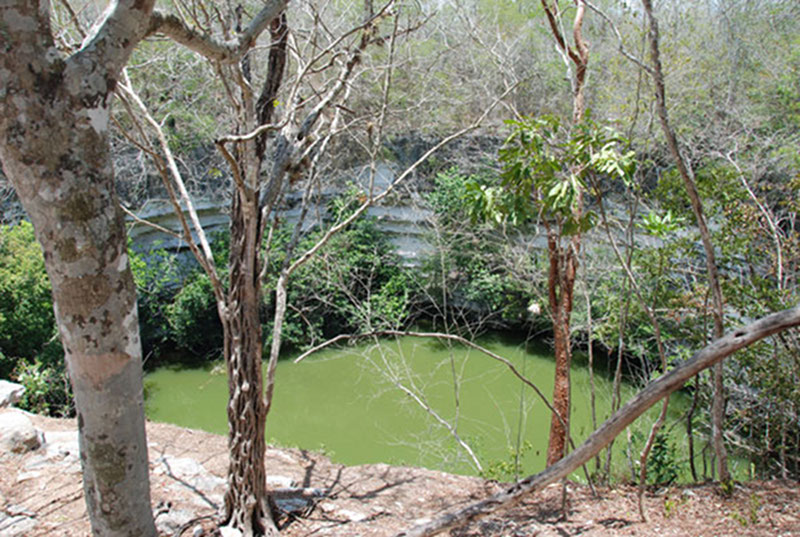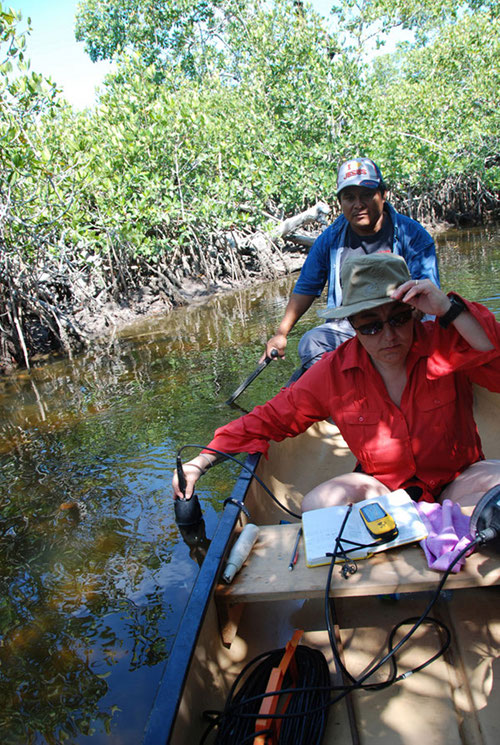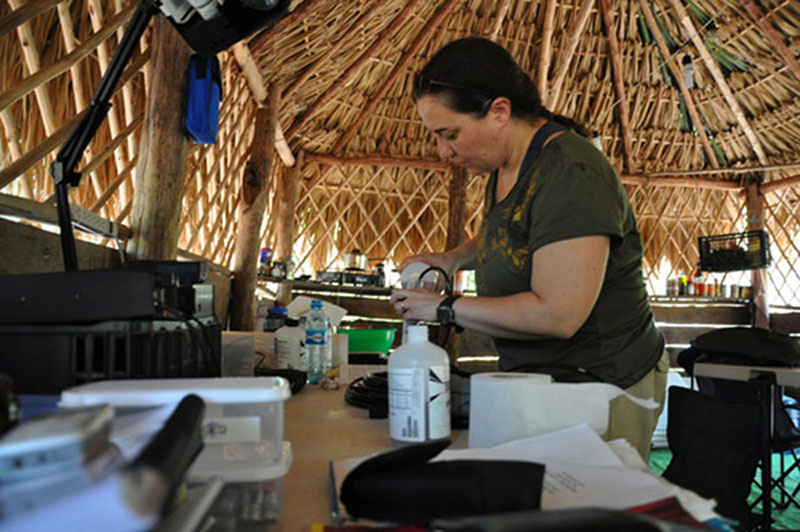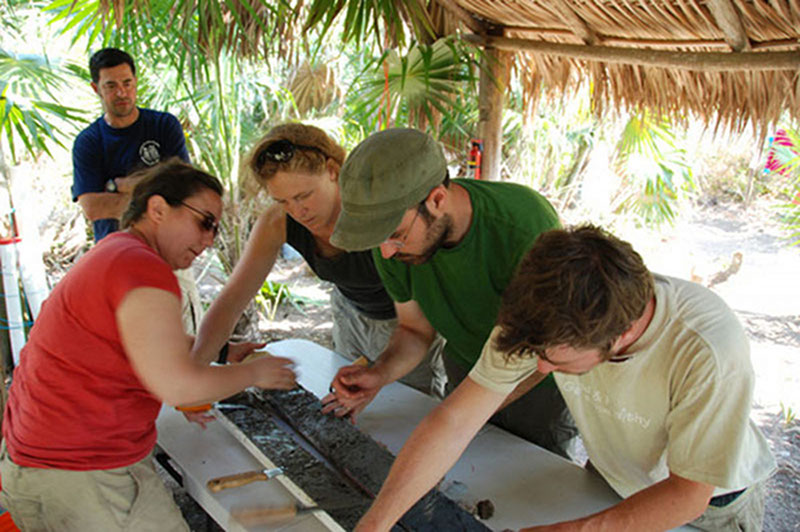
By Patricia Beddows, Department of Earth and Planetary Sciences - Northwestern University
September 19, 2011
The Costa Escondida is a dirty and thirsty place these days. I am sitting here looking at my dry, blacked, and cracked feet. My ears crunch with salt, even though I had my mid-day swim. The water was uncomfortably warm Cenotes provided the ancient Maya with the majority of their water needs. This large cenote, located at Chichen Itza has a green color due to algal blooms. This site served an important role to the large city for sacrifice, while another cenote also within the archaeological site was reserved for water supplies. and slimy. My quick swim was good to cool off, but now my skin just feels weird.

Cenotes provided the ancient Maya with the majority of their water needs. This large cenote, located at Chichen Itza has a green color due to algal blooms. This site served an important role to the large city for sacrifice, while another cenote also within the archaeological site was reserved for water supplies. Image courtesy of Proyecto Costa Escondida Maritime Maya 2011 Expedition, NOAA-OER. Download larger version (jpg, 5.0 MB).
It is not a complete surprise that this land is parched. We did purposefully come here at the driest of the dry season in the month of May. For 15 years I have been studying the water supplies in the Yucatan Peninsula of Mexico, including in my favorite month of May when the mosquitoes are almost absent. These are the days when clouds might form overhead eager to rain, but they all pass on since they are not yet heavy enough to quench the land. In all my experiences though, this site of Vista Alegre nestled in the northern Costa Escondida is particularly dry.

Dr. Patricia Beddows dips the hydrolab into waters near Vista Alegre, searching for any trace of freshwater in the vicinity of the site. Almost all the waters in close proximity to Vista Alegre were not just saline – but “hyper-saline”, exceeding the salinity of sea-water. Image courtesy of Proyecto Costa Escondida Maritime Maya 2011 Expedition, NOAA-OER. Download larger version (jpg, 4.3 MB).
In the Yucatan, I have always managed to be within a few steps of fresh groundwater in this vast karst landscape. The whole platform is soluble limestone, a soft carbonate rock that easily forms water filled sinkholes and skylights from the jungle into the underground. These magical pathways to fresh groundwater are called d’zonot in Maya, or cenotes in their Spanish version used today. There are no rivers here, and the cenotes provided the Maya with all their water needs, allowing them to dip into one of the world’s greatest fresh water reservoirs. However here at the Vista Alegre site, we are faced with the mystery of not only no rivers, but also no cenotes, and no coastal springs. There is simply no fresh water to be found – or at least it is not clear where it may be, and where there may have been water supplies in the past. How could the Maritime Maya who lived, traded, and thrived at this parched site? That is the question that I am focusing on for this big project.
I set to work diligently measuring the chemistry of all the water surrounding our site trying to find a hint of fresh water, that we might then trace back to a cenote or a coastal spring to solve the mystery. As I dip the Hydrolab into the water I am surprised to have a reading of 130% marine salinity on the screen. With a not-so-quiet muttering, I get out of the canoe, and trudge back to base camp to yet again recalibrate the sensors, since obviously I did not do it correctly the first time. I yell over my shoulder “Just go on without me – our canoe will catch up with you all once I get this Hydrolab calibrated.”

At the site’s main palapa, which served the expedition team as a work-space, kitchen, dining area and sleeping area, Trish Beddows calibrates the hydrolab in preparation of surveying the water chemistry of the site. Image courtesy of Proyecto Costa Escondida Maritime Maya 2011 Expedition, NOAA-OER. Download larger version (jpg, 1.9 MB).

Trish Beddows, Beverly Goodman, Wes Patterson and Dan Leonard work together to open up one of the first cores pulled from the sediments near Vista Alegre, while Dominique Rissolo looks on. Trish and Beverly will analyze samples from the cores to look back at the site’s prior ecology, and water chemistry. Image courtesy of Proyecto Costa Escondida Maritime Maya 2011 Expedition, NOAA-OER. Download larger version (jpg, 3.2 MB).
Back at the palapa, I find to my surprise that the Hydrolab is reading the salinity perfectly well. And so came the realization that not only was fresh water going to be a challenge to find, but in fact the whole archeological site of Vista Alegre was surrounded by “hyper-saline” water categorically unfit for human consumption. How did the Maritime Maya survive?! Could conditions have been so different here even 2000 years ago that fresh water supplies were sufficient? Could there have been springs and cenotes that used to flow into the estuaries and the ocean, but that have now been dammed shut by the rising sea level?
I know I will need patience, both in my current hunt for fresh water in the present day, and also over the months to come as Beverly Goodman and I unravel the story of what used to be here. From the sediment cores that we are collecting on this expedition, we will unravel stories of the past ecology, the past water chemistry, and especially changes in the abundance and species of beautiful forams entombed in the mud that Bev specializes in. Each type of foram is highly sensitive to the water conditions they live in, and so will tell us if the waters here have long been slimy and hypersaline as they are today, or were once diluted by discharging fresh cool groundwaters which would also have supported the Maritime Maya at this most significant port city of Vista Alegre.
I can hardly wait to catch up with the coring crew – I don’t want to miss the first core being pulled! I must however slow down to measure the salinity of all the waters as we canoe out to the site.